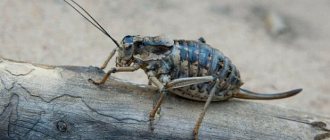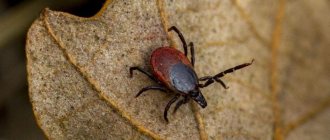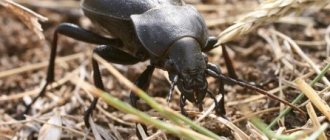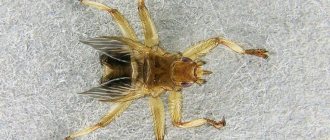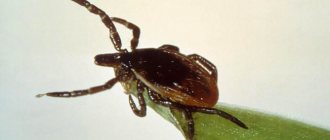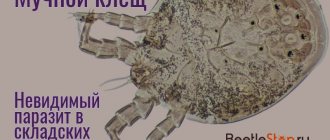Can ticks jump and how do they attack people? Behavior of ticks in natural conditions. How active they are and how they move. Description and characteristics of parasites. The deer sucker is a flying parasite, which makes it dangerous. What you need to know about ticks to protect yourself.
When we go into nature, we try to protect ourselves as much as possible from ticks. These small blood-sucking creatures are not just unpleasant, they are very dangerous, because there is always the possibility that the parasite will not just bite and drink blood, but can transmit an infection that causes serious complications.
We try to avoid thickets, select clothes that protect the body, use a variety of specialized means, but despite all these actions, the parasite can still attack us. Of course, the question arises about how they move, jump, crawl or fly, because he needs to cover a long distance to attack his prey.
How the attack occurs
It’s worth immediately dispelling the main myth: ticks cannot fly. They simply do not have the adaptations for flight, as well as for jumping. But the main danger is different: they have very tenacious limbs. As soon as you touch the grass or bush where the tick lives, the parasite will immediately cling to your clothing and crawl.
An insect can fall on a person, but again, the height of its habitat is limited. Maximum - if you carelessly touch the bush. There are people who claim to have seen ticks flying. They are mistaken - there is an insect that is similar in appearance and properties to this parasite, but is not it.
There's nowhere to hide
Ticks are the most numerous representatives of their class. In total there are more than 54 thousand species. And new ones are constantly being added to the existing ones. So, in 2006, a graduate student at Moscow State University found previously unknown oribatid mites that lived 6 thousand years ago. And recently, scientists from Tyumen University discovered a new species of this group of arachnids in South Africa. The discovered mites feed on fungi and spread by attaching themselves to the body of termites.
According to researchers, termite mounds in South Africa as a habitat for arthropods have not been particularly studied, so this is probably not the last interesting find. Photo:
Without exaggeration, you can meet ticks everywhere: even in the Arctic and Antarctic, where they parasitize penguins and other birds. There are also aquatic species, the victims of which are insects and bivalves. What allowed ticks not only to survive for so long, but also to multiply to incredible numbers? Their amazing ability to survive.
Thus, Discover published an article about the experiment of Yasuhito Ishigaki from Kanazawa Medical University. He photographed the moving mites using a scanning electron microscope.
To obtain an image on this device, small arthropods had to be first dried, coated with metal, and in the microscope itself they were in a vacuum and subjected to “bombardment” of high-energy electrons. Few would withstand such conditions, but the ticks in the video are cheerfully “waving their paws.”
Ishigaki o.
People started talking about adaptation of animals in vacuum conditions after experiments on tardigrades. These microscopic invertebrates, which are closely related to arthropods, show amazing endurance, surviving in extremely low temperatures, high pressure, radiation and outer space. But in order for their superpowers to work, tardigrades need to go into suspended animation, while ticks survive in their normal state. Photo:
Mite with wings - description of the pest
The elk tick lives on artiodactyl animals, such as deer, elk and others. They often attack:
- bears;
- badgers;
- fox;
- wild boars;
- sheep;
- goats;
- cattle.
During an attack, the insect's wings break off and its legs are attached by hairs. That is why it is confused with a tick.
To avoid such a mistake, you need to remember exactly what the parasite looks like:
- Outwardly, it looks like a small light brown fly. The body size is no more than 3.5 mm. Moreover, males are smaller than females.
- It has an elastic soft belly. When eating or bearing offspring, it can easily stretch.
- He has 6 strong legs that grow from his chest. At the ends you can see small asymmetrical claws.
- The eyes have a faceted structure, and the antennae are located on the head. The insect's vision is quite poor, so it has to navigate the terrain and contours of its prey.
- Transparent wings are arranged according to the gods of the body. They are quite developed, but the insect is not capable of flying over long distances.
- It easily manages to pierce human or animal skin, as it has a piercing-sucking type of mouthparts.
Does the moose bloodsucker attack humans?
As practice has shown, people also become victims of insects. Most often, attacks occur in a forest or field during the day, when there is no wind. Therefore, shepherds, hunters and foresters are primarily at risk. Rapid activity of parasites occurs in mid-August and September.
A statistical study was carried out, during which it was revealed that the deer bloodsucker is attracted to large dynamic objects.
Let's celebrate! That's why they attack adults and are not interested in children. There are several cases when a person was attacked by just under 100 individuals in one minute.
How does suction occur?
As soon as the parasite has climbed onto a person, it begins to make its way under clothes and suck out blood. This does not happen immediately, but after half an hour. Basically, bloodsuckers try to get on the head, as there is an opportunity to catch on the hair.
Note! The parasite is quite difficult to shake off or remove. They can hold up even while running or in strong winds. The moose tick will remain on the human body until it accidentally falls off or is removed.
Danger to humans
Reactions to deer bloodsucker bites can vary. It all depends on the individuality of the human body.
The following consequences are observed:
- Mild discomfort that usually goes away after a couple of days.
- Severe pain syndrome, which is accompanied by itching, redness, burning and swelling. This may take several weeks.
- Dermatitis of various types appears. The mild form of manifestation is redness, and the severe form is rash, crusts and blisters.
Let's celebrate! Unlike an ordinary tick, this parasite does not cause serious harm to the human body, since it is not a carrier of encephalitis and other diseases.
Life cycle
The vital activity of ticks begins when the air temperature rises above 1°C. The mating season for ticks is May-June. After this, the fertilized females drink the blood and begin to lay eggs. Tick activity subsides at this time.
How many eggs a tick lays depends on its type and life expectancy. A female tick can lay from 100 to 17 thousand eggs in her life. In nature, ticks lay eggs in soft, moist soil. In urban conditions, how will it work? If the female “arrived” at the apartment on a dog and was not noticed, she will lay eggs right in the living room. After some time, the apartment will be filled with actively moving transparent larvae 0.5 mm in size.
Tick development cycle
Stages of development
The maximum number of development stages in parasites is 4:
- egg;
- larva;
- nymph;
- imago.
Tick eggs are very large in size relative to the female. They can be of various shapes, with a smooth or textured shell.
After some time, depending on the temperature and humidity of the environment, mite larvae emerge from the eggs. These are very small organisms measuring no more than 0.5 mm. They look almost like adults, but have only 3 pairs of legs. The tick larva does not have its own name, since it has only one stage of development.
Knowing about the “three times a day” diet of acarids, many doubt whether the tick larva is really dangerous to humans. After all, she hasn't drunk blood yet. For many diseases, no, it is not dangerous. But encephalitis can be transmitted to the larvae by a female tick during egg laying. Therefore, even a larva can infect encephalitis. And therefore, it is dangerous for humans.
After consuming blood, the larva falls into torpor and transforms into a nymph. This stage takes a little time.
Three stages of nymph development
The development of nymphs occurs in 3 stages. Each stage has its own name for nymphs:
- protonymph;
- deutonymph;
- Tritonymph.
The tick nymph is distinguished from the adult only by a smaller number of bristles on the paws and genitals, a smaller number of genital tentacles, and a smaller size. The size of the nymph is 1-1.5 mm.
The tick nymph is much more dangerous to humans than the larva. You have to be “lucky” to stumble upon a young arthropod infected with encephalitis right from the egg. The nymph had already fed once on her own and could drink the blood of a sick animal.
Some species of ticks skip the deutonymph stage, others do not go beyond the second. In ixodids, the main factor triggering the transformation of a nymph into an adult is blood feeding. If the nymph remains hungry, she will go to winter without turning into an adult.
Generation of tick generations
Imago
After the mechanism of transformation of the tritonymph into an imago is launched, the nymph experiences serious changes in the structure of the body:
- the structure of the external integument becomes more complex;
- the number of bristles increases;
- in higher species the following are formed: trachea, shell, pteroforms, plates and much more.
“Full-fledged” mites are born only after the tritonymph moults. In structure they are very different from larvae and nymphs.
How high can ticks climb?
When hunting, the optimal height for climbing a plant or shrub is from 20 to 50 centimeters above ground level. Depending on the bends of the plant and the terrain, the tick can rise to a height of up to one meter. Such low positions allow the parasite to remain invisible and easily latch onto the host’s legs.
Having attached itself to a person, the bloodsucker can reach the head in about an hour. Therefore, after returning from the forest, it is important to inspect clothing and exposed parts of the body for ticks. In most cases, due to the slow movement, it is possible to remove the parasite that is still crawling towards the head.
Do ticks run fast?
Not fast at all. In its entire life, a tick may not crawl 10 meters.
In most cases, the prey itself comes to the hunter. Thus, the bloodsucker does not need the ability to move quickly. It is much more important for him to take an advantageous place for hunting, to latch on, and, probing every millimeter of skin, to find the most tender and safe place to bite.
If you wait for a long time, the tick may decide to move to the nearest source of blood at a distance of up to 100 meters. This will take him about 3 months. Therefore, tourists staying in the forest for a long time should be prepared for the arrival of bloodsuckers.
Infection process
Once on the human body, the tick moves for a long time in search of the most suitable place to bite. It usually stops where the skin is more delicate and thin and there are many blood vessels. These could be places:
- on the neck;
- behind the ears;
- in the groin area;
- in the armpits;
- in the popliteal cavities.
After a bite, the saliva of the arthropod enters the bloodstream, and with it the disease virus. It travels through the bloodstream throughout the body, including reaching the brain.
Danger to people
In fact, attacks by these insects are quite common. They live in forest thickets, but in search of food they also visit other territories, so they can be found not only in forest areas, but also in fields. Most often they attack from above, jumping on their heads. This is due to the fact that this way they can cling to the hair and securely attach to the victim. It is impossible to predict the body's reaction to a parasite bite, since everyone experiences it individually.
Some people may not notice the bite at all, after which there will only be a small spot of red and color, and after 2-3 days it will disappear. Others, during a bite, feel very severe pain, after which the affected area turns red, inflamed and itchy. Situations are possible when a person has an allergic reaction to the saliva of the parasite and it occurs in a rather complex form.
The affected area becomes inflamed and swelling is observed, accompanied by severe itching. A rash and blisters may appear, and dermatitis may develop. If a person is predisposed to urticaria, he develops edematous dermographism. Symptoms do not disappear quickly and the condition can last up to 3 weeks.
When the body's reaction is severe, treatment with medications is required. It is worth saying that a person tolerates the initial attacks of the parasite quite easily. Since the small amount of toxins that enter the body is quickly neutralized by the immune system. But subsequent bites are quite dangerous and can be tolerated in severe forms.
Studies were conducted that showed that 25% of moose ticks were carriers of dangerous spirotechs. Spirotechans are the causative agent of Lyme disease.
Most often, these bloodsucking creatures attack adults, but do not attack children under 8-10 years of age. This feature is due to the fact that they parasitize large animals. But here it is worth considering that during periods of maximum activity, when they need food, they can attack any victim in order to satisfy their hunger. These individuals can attack a person in groups; there are known cases, and they are not isolated, when about 100 elk ticks attacked one person at once.
What places to avoid
Unfortunately, there are simply no places where complete safety from these parasites is guaranteed. Regardless of whether you are going on vacation to the Moscow region or another region, during periods of activity they can be found in absolutely any territory.
There are some weather conditions that are not entirely suitable for them, such as dry and hot weather. Then they prefer to hide in shaded places where humidity is maintained. Large populations are found in deciduous and mixed forests; there are more favorable conditions for development and reproduction.
Regarding places that are best avoided in September and other warm periods, these include tall grass, shaded areas, willow trees, lake and river banks, and ditches. Of course, they can also be found in urban environments, especially parks. There is an opinion that parasites attack people by jumping from trees; these assumptions are misleading.
The fact is that these insects cannot tolerate direct sunlight, the ideal temperature is up to 21°C and necessarily high humidity. There are no favorable conditions for them at the tops of trees. In addition, these small parasites move very slowly and cannot cover long distances, and climbing to the top of a tree is not an easy task.
They are quite intelligent and hide in the grass and bushes near animal trails, where prey often passes and is easy to attack. In urban environments, they attack dogs and cats from the grass, and if a person passes, they cling to the legs and crawl upward to find a place to bite.
How to remove a parasite
If you find a moose tick on your body, it must be removed as quickly as possible. The right thing to do in this situation would be to contact medical institutions, but if you consider that they attack in nature, then often this is not possible.
In order to remove it yourself, you can resort to the following methods:
- Tweezers. It is necessary to grab the parasite under the abdomen and begin to twist it clockwise with careful, leisurely movements. It is very important not to make sudden movements, since the body can be torn off, and the proboscis will remain in the wound. If part of the bloodsucker remains under the skin, then inflammation will begin.
- Vegetable oil. They need to lubricate the parasite and the bite site well. The oil does not allow oxygen to pass through, which leads to the person suffocating and sticking his head out on his own. You can also use other fatty products instead of oil.
- Thread. It is necessary to make a loop and put it on the tick, then gently move it from side to side and slowly pull it out.
To be able to identify the infection at the initial stage of infection, the parasite must be submitted to a laboratory for laboratory testing. Such studies are carried out with a living individual, which gives the most accurate results. To do this, after removing it, put it in a glass container and place a piece of damp cloth there to preserve its vital functions.
Treatment
There is no single treatment regimen for bites of these bloodsuckers, since different reactions of the body are observed. Remember that when scratching the affected area, various infections can occur, which is also dangerous for complications. After removing the parasite, the bite site must be treated with an antiseptic.
To relieve symptoms, for example, get rid of itching, you can use Fenistil gel, which will also speed up the healing process. For allergic reactions, Suprastin, Zirtex and other drugs are used. The wound must be sealed with a bandage.
If we talk about traditional methods, you can use aloe juice, which will relieve itching and speed up healing, as well as calendula tincture. You can use regular ice, it will reduce inflammation and swelling. Soda is used, which is diluted with water to a paste and applied to the wound.
Preventive measures
In this case, the same preventive actions that we use to protect ourselves from ordinary ticks are effective. Proper clothing that covers the entire body. Jacket with cuffs and a collar close to the neck. The pants are tucked into the socks, and the jacket is tucked into the pants. A headdress is a must.
Avoid bushes and stick to paths and open areas. Check your clothing for ticks as often as possible. Be sure to use repellents that protect against most parasites and are most effective in natural conditions.
Why is the deer bloodsucker dangerous for animals?
In large quantities, moose ticks systematically drink the blood of animals, as a result they become restless, stop sleeping and eating normally, as a result of which exhaustion occurs, and the growth of young animals slows down. In addition, regular blood loss can lead to their death.
Deer is the main host and supporter of the deer bloodsucker
The deer bloodsucker can be found on the body of the following animals:
- roe deer, deer, elk, deer - representatives of the family of artiodactyl mammals;
- cattle;
- wild boars, bears, dogs, foxes, badgers, goats, sheep and others - their parasitism was noted.
Insects drink the blood of animals about 15–20 times a day. Sexually mature females feed more often than males. When it comes to pets, it is impossible to specifically prevent the appearance of parasites. A person can save them from the long-term presence of deer bloodsuckers using special aerosols and sprays to kill insects such as flies, mosquitoes, and ticks.
What to do after a bite
If an arthropod was caught “in flagrante delicto,” it is carefully removed, placed alive in a jar, and taken to a laboratory for examination. If traces of an attack are found without the bloodsucker, the irritated area is lubricated with an anti-insect bite remedy.
Help with a tick bite
After an attack by an uncaught tick, a person will have to monitor his health for about a month. The incubation period for some Ixodid-borne diseases can last up to 30 days.
Victims often have questions about whether it is possible to wash after a tick bite. After all, in this case there is a risk of wetting the irritated area. But the bite is not a tuberculin test, although it is similar in appearance. You can safely swim after a tick bite or take a bath
All precautions are related not to traces of an attack, but to the state of human health. If a victim attacked by an arachnid has a weak heart, then the person may not be able to withstand the steam room
Playing sports is not only possible, but also necessary. An attack by blood-sucking arthropods would be no different in consequences from an attack by insects, if not for the delayed consequences. The likelihood of contracting infections from an insect is lower than from an arachnid. An insect drinks blood once, a tick at least 3 times - once for each stage of its transformation into an adult animal. The likelihood that he will first take a treat from a sick animal, and then transmit the causative agent of the disease to a person, is much higher.
How to deal with moose fleas
There are cases that ectoparasites are found in the backyard of a private house. In this case, the area should be treated with chemicals. This must be done carefully in places where grass grows; high growths must be mowed to eliminate the habitat of ticks with wings.
Salmon flies are repelled by the smell of tansy and wormwood, so it is recommended to plant it near the house. Trees and bushes need to be sprayed regularly with water, moisture is the enemy of the deer bug.
It also does not tolerate strong odors, so garlic tincture is used for watering or spraying. There are also special treatment products that do not harm plants and pets.
To prevent contact with a deer bloodsucker, do not neglect safety measures (wear appropriate clothing, use repellents). It is important to take disinfectants and antihistamines with you. To avoid bringing bloodsuckers home, clothes after a walk should be checked for the presence of attached ticks.
Deer bloodsucker in the apartment: how to get rid of it
Moose ticks usually live in nature, since this is where most of the animals they feed are located, however, sometimes they can be found in an apartment or private house. Most often this happens if there is a park, forest, large-scale natural recreation area or nature reserve near your home. The likelihood of moose ticks increases significantly if there are stables or enclosures with mammals in these places.
If you have a deer bloodsucker in your apartment, how to get rid of it you can choose from two options, which are essentially one, just in different designs. We are talking about poisoning parasites with chemicals. This can be done either independently or with the help of SES. In the latter case, you need to order the service of treating the entire apartment from insects, and the problem with bloodsuckers will be solved in just 1 day if you contacted a SES certified by Rospotrebnadzor with many years of experience.
You can try to treat your apartment from parasites yourself using products for exterminating crawling and flying pests with a wide spectrum of action, for example, such as:
- Raid or Raid Max aerosol
- Raptor universal protection against 17 types of insects
- Tsipromal
- Lambda Zone
- Gett
- Xulat
- Contra Insect
- Combat MultiSpray, PowerSpray or SuperSpray
- Medilis Super
- Aerosol Delicia
Bloodsuckers not only crawl and fly around your house, but also directly attack your body and health, so the sooner you get rid of them, the better. It makes no sense to devote time to useless attempts to deal with them using folk or other non-chemical methods, since they will scare off the parasites only for a while, without completely solving the problem.
Small and remote
What factors influence the endurance of ticks? Each species is different. For example, in 2014, a small tick from Southern California rightfully won the title of “fastest on the planet.” Of course, relative to the length of your body. Paratarsotomus macropalpis has an average speed of 192 body lengths per second. And the maximum length of this arthropod is 322 lengths. For comparison: the equivalent of this speed for people is 2092 kilometers per hour!
In addition, the researchers discovered: Paratarsotomus macropalpis moves at the same speed on concrete heated to 60 °C. And also the fact that the experimental ticks very quickly change direction and stop. According to biologists, the data obtained can be used to create robots and ultra-fast mechanisms.
By the way, a cheetah, capable of running at a speed of 96 kilometers per hour, overcomes only 16 body lengths per second Photo: i.wp-b.com
Speed is good, but, of course, the main factor in the survival of ticks was their adaptive features. Thus, in 2016, a study of the tick genome was published, in which scientists found unique parasitism genes. Biologists are targeting Ixodes scapularis, black-legged ticks that spread many viral and bacterial infections.
Over millions of years of living as “freeloaders,” these arachnids have developed a lot of different adaptations, which are encrypted in their truly huge genome (2.1 billion nucleotide bases). For comparison: this is only 3 times smaller than the human genome. It took scientists 10 years to decipher the DNA of black-legged ticks. Biologists were especially struck by the variety of genes that encode the multicomponent protein cocktail of saliva: compounds that suppress excessive bacterial growth at the site of the bite and suppress the host’s immunity, cementing and analgesic substances, etc.
Miniaturization, that is, reduction of the body, is one of the common processes during evolution. And this is one of the reasons that allowed ticks to achieve such a flourishing: their microscopically small size gave them the opportunity to colonize the upper layers of the soil, which are rich in decomposing plant debris. For example, the length of Eriophyidae, a mite that parasitizes plants, ranges from 125 to 250 micrometers Photo: cdn3.img.ria.ru
Other types of ticks also show unique adaptive abilities. Thus, a 2015 study showed that Demodex acne mites, which live on the skin of most people, are inherited and have evolved with their host for millions of years.
Varroa destructor species parasitize bee pupae, and in order to get into the hive they imitate the set of pheromones of their hosts. Initially, their objects were only Asian representatives of Hymenoptera, but since the 60s of the 20th century the situation has changed. At the same time, bees of each species produce their own unique chemical signals. To understand how quickly the process of restructuring occurs in mites, French and Chinese biologists conducted an experiment by introducing an Asian parasite to a pupa from Europe and vice versa - a European arachnid to a hive with bees from Asia. The result was amazing: it took the ticks only 8 days to learn to produce new pheromones.
Of course, every rule has exceptions: some species of ticks do die out. So, in 1952, the last time a living Caribbean monk seal was seen. Along with them, rare mites that lived only in the noses of these animals disappeared. Photo: upload.wikimedia.org
How to protect yourself from moose lice in the forest?
Now you know that moose fleas are dangerous to humans, so a trip to the forest should be carefully considered. Experts recommend:
- wear clothing that covers the entire body;
- the trouser legs, cuffs and collar must fit tightly, otherwise the moose fly, which we described above as a dangerous bloodsucker, will crawl into the holes towards the body;
- treat your hands, face, and neck with repellents. Typically, moose lice treatment is made with DET;
- apply repellent to clothing. If you have any difficulties purchasing a ready-made repellent, you can use regular tar soap. This remedy for moose lice in the forest will save you no less effectively;
- Bring with you special tools for removing ticks - a lasso handle, a tick gun or an ordinary strong thread. After physically feeling the bite, you need to try to remove the blood-sucking fly as carefully as possible by pulling its proboscis out of the body;
- take hydrogen peroxide and iodine, hand sanitizers and an antihistamine for moose flies in your backpack - the person providing assistance also sanitizes the hands.
Removing the insect will not be easy. It must be remembered that a flat fly is a sticky one, having a body structure in which classical physical methods of fighting do not work. If there is no confidence that the ectoparasite will be correctly extracted, you need to use oily substances. If complications are detected, consult a doctor immediately. It often happens that a moose fly is found in an apartment. In this case, you need to try to drive it out or scare it off with repellent.
Methods for controlling moose ticks
How to deal with bloodsucker? There are several effective methods - industrial and folk.
Terrain processing
Powerful insecticides are used to treat the area. Samples of the first generation caused irreparable harm not only to mites, but also to trees, so they were used only when absolutely necessary. But modern products are absolutely safe for people, indoor plants and pets.
Spraying of chemicals occurs using a special device that breaks down insecticides to the consistency of cold gas. Such steam generators guarantee that poison gets into hard-to-reach areas. At the final stage, hot steam treatment is performed, which does not leave the slightest chance for parasites.
Room treatment
To remove moose ticks from indoors, use liquid carbon dioxide cooled to -50 degrees. No living creature can survive in such cold.
Regular mowing
To protect summer cottages from moose bloodsuckers, you need to mow the grass more often. It is in dense and tall thickets that they most often appear.
Moose ticks, like many other insects, love to live in thick grass, so you need to keep your lawn mowed regularly.
Spraying lawns
Experts advise regularly spraying lawns and trees with ordinary water - ticks hate moisture. To be safe, add alcohol and crushed garlic, a decoction of tansy and wormwood. Planting wormwood or tansy in areas where elk flies are permanent habitats is also suitable.
Using repellents
Before going into the forest, apply a strong repellent that contains DET to your clothing. They have a repellent effect and will not allow ticks to get to the distance you need to jump. An alternative to store-bought products is a bath or shower with tar soap foam.
See also: Moose fly - why it is dangerous and how to fight it (video)
Where does everything go?
To accumulate and store the nutrient fluids they receive, mites have a coating of elastic cuticle . If necessary, it stretches and contains everything that the insect sucks. The structure of the cuticle in females and males is somewhat different. As a result, in females it straightens and stretches noticeably more. This allows females to accumulate more necessary nutrients. Why? Because they need to raise their offspring. To achieve this, nature provided them with certain nutritional advantages compared to males.
The legs of ixodid ticks have tooth-like projections that allow them to hold tightly to the surface of the host’s body. Especially when they get drunk. At the ends of the paws there are two powerful claws . Between them there is a kind of “pad”. It acts like a suction cup, which further fixes the position of the parasite on the victim.
